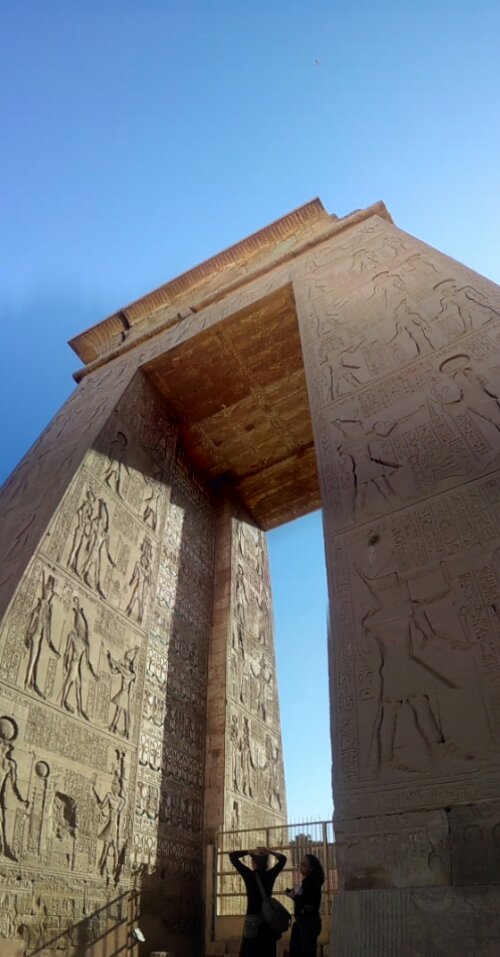
Since we’d already slept all night, we dropped our bags in our room – a simple space with bold arabesques painted on the wall – and headed up to the rooftop patio. From there, sipping tea and Nescafe (yes, instant coffee and unfortunately ubiquitous in Egypt. Later we’d switch to Turkish coffee which didn’t seem all that strong either.)
Our view from the rooftop was lovely. The Avenue of the Sphinxes, ending just to our left at the Luxor Temple, stretched out from left to right parallel with the road that lay between us and it and the Nile which quietly flowed on it’s other side. The Avenue of the Sphinx stretches from the Luxor Temple to the Temple of Karnak, some 3km away. The Avenue has been mostly buried for centuries and was only uncovered a few years ago. Like so many other projects though, it’s been put on hold while the government situations works out itself out and so it sits as great holes stretching through the city, gathering trash.

Curiosity to explore pulled us down from the roof and soon the four of us were headed to the Luxor Temple. Carriage drivers – with their ornate carriages and underfed horses solicited us for rides – they would take us to the government bazaar, today only! – they would take us to the camel market, only 2 pounds! – (Mohammed informed us that the government bazaar is usually just a small shop that a cousin owns and the camel market, while it exists, is actually 100km away). Taxi drivers too were happy to take us anywhere we pleased. Young kids offered to sell us a map, a papyrus bookmark. How about you just give us money. We ignored them for the most part although Violet seemed frequently to have a tendency to engage with people… dammit for wanting to connect!
The Luxor Temple dates back to 1400 BC and was built mainly by Amenhotep III and Ramses II and was used as a celebratory space for the Opet Festival involving the gods Amun and Mut. Atop it sits a mosque which we entered the mosque first. I had a feeling it wasn’t leading into the ruins but the imam welcomed us. “Here, let me show you,” he said, welcoming, and he proceeded to guide us through the small Mosque of Abu Haggag, built in 1100 AD atop the ruins of the temple. There is a nice legend about it that can be read here. The mosque was built when much of Luxor Temple was still buried. The sands of Egypt and the Sahara are known for burying history.
Throughout the mosque are the tops of columns from the original Luxor Temple with hieroglyphs inscribed upon being used for support and internal structure, one religion built atop the ruins of the previous belief system. The view from the mosque into the courtyard was quite nice – we could see the giant statues of Ramses II and the rows of pillars from above. Eventually we made to leave and the Imam cornered us asking for money to give to the mute fellow who’d followed us around the entire time – “For the orphanage!” he said holding out his empty hands, “think of the children!”
*Sniff*. It’s an old, old game, the ‘what about the children’ question. So we gave him 30 pounds or so – 5 dollars between us. He gave us some booklets about Islam. They are free! He implored us to take them. Later we told Mohammed about the Imam and the orphanage. For the orphanage? he laughed. “Imams are like that – they are always like that. They put out their hand and ask for money for Allah or the children or whoever and with their other hand they pocket it. I do not need an imam. I am my own imam. Mohammed – he is my imam.” And he patted his chest, his heart.
